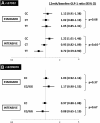Modulation of GLP-1 Levels by a Genetic Variant That Regulates the Cardiovascular Effects of Intensive Glycemic Control in ACCORD
- PMID: 29183908
- PMCID: PMC5780047
- DOI: 10.2337/dc17-1638
Modulation of GLP-1 Levels by a Genetic Variant That Regulates the Cardiovascular Effects of Intensive Glycemic Control in ACCORD
Abstract
Objective: A genome-wide association study in the Action to Control Cardiovascular Risk in Diabetes (ACCORD) trial identified two markers (rs57922 and rs9299870) that were significantly associated with cardiovascular mortality during intensive glycemic control and could potentially be used, when combined into a genetic risk score (GRS), to identify patients with diabetes likely to derive benefit from intensive control rather than harm. The aim of this study was to gain insights into the pathways involved in the modulatory effect of these variants.
Research design and methods: Fasting levels of 65 biomarkers were measured at baseline and at 12 months of follow-up in the ACCORD-Memory in Diabetes (ACCORD-MIND) MRI substudy (n = 562). Using linear regression models, we tested the association of the GRS with baseline and 12-month biomarker levels, and with their difference (Δ), among white subjects, with genotype data (n = 351) stratified by intervention arm.
Results: A significant association was observed between GRS and ΔGLP-1 (glucagon-like peptide 1, active) in the intensive arm (P = 3 × 10-4). This effect was driven by rs57922 (P = 5 × 10-4). C/C homozygotes, who had been found to derive cardiovascular benefits from intensive treatment, showed a 22% increase in GLP-1 levels during follow-up. By contrast, T/T homozygotes, who had been found to experience increased cardiac mortality with intensive treatment, showed a 28% reduction in GLP-1 levels. No association between ΔGLP-1 and GRS or rs57922 was observed in the standard treatment arm.
Conclusions: Differences in GLP-1 axis activation may mediate the modulatory effect of variant rs57922 on the cardiovascular response to intensive glycemic control. These findings highlight the importance of GLP-1 as a cardioprotective factor.
Trial registration: ClinicalTrials.gov NCT00000620.
© 2017 by the American Diabetes Association.
Figures


Similar articles
-
Genetic Predictors of Cardiovascular Mortality During Intensive Glycemic Control in Type 2 Diabetes: Findings From the ACCORD Clinical Trial.Diabetes Care. 2016 Nov;39(11):1915-1924. doi: 10.2337/dc16-0285. Epub 2016 Aug 15. Diabetes Care. 2016. PMID: 27527847 Free PMC article.
-
Association of RASGRP1 polymorphism with vascular complications in Chinese diabetic patients with glycemic control and antihypertensive treatment.Cardiovasc Diabetol. 2024 May 10;23(1):166. doi: 10.1186/s12933-024-02267-2. Cardiovasc Diabetol. 2024. PMID: 38730425 Free PMC article.
-
Genetic Tools for Coronary Risk Assessment in Type 2 Diabetes: A Cohort Study From the ACCORD Clinical Trial.Diabetes Care. 2018 Nov;41(11):2404-2413. doi: 10.2337/dc18-0709. Epub 2018 Sep 27. Diabetes Care. 2018. PMID: 30262460 Free PMC article. Clinical Trial.
-
Cardiovascular disease and intensive glucose control in type 2 diabetes mellitus: moving practice toward evidence-based strategies.Vasc Health Risk Manag. 2009;5:859-71. doi: 10.2147/vhrm.s4808. Epub 2009 Nov 2. Vasc Health Risk Manag. 2009. PMID: 19898642 Free PMC article. Review.
-
Glycemic control and cardiovascular disease: what's a doctor to do?Curr Diab Rep. 2012 Jun;12(3):255-64. doi: 10.1007/s11892-012-0268-5. Curr Diab Rep. 2012. PMID: 22467273 Free PMC article. Review.
Cited by
-
The Need for Precision Medicine to be Applied to Diabetes.J Diabetes Sci Technol. 2020 Nov;14(6):1122-1128. doi: 10.1177/1932296819894295. Epub 2020 Jan 6. J Diabetes Sci Technol. 2020. PMID: 31903769 Free PMC article.
-
Pharmacogenetics of new classes of antidiabetic drugs.Bosn J Basic Med Sci. 2021 Dec 1;21(6):659-671. doi: 10.17305/bjbms.2021.5646. Bosn J Basic Med Sci. 2021. PMID: 33974529 Free PMC article. Review.
-
Cardiovascular disease in diabetes, beyond glucose.Cell Metab. 2021 Aug 3;33(8):1519-1545. doi: 10.1016/j.cmet.2021.07.001. Epub 2021 Jul 21. Cell Metab. 2021. PMID: 34289375 Free PMC article. Review.
-
Serum Selenium and Age as Predictors of Metabolic Health in Middle-Aged Women: A Regression-Based Study.Nutrients. 2025 Apr 24;17(9):1429. doi: 10.3390/nu17091429. Nutrients. 2025. PMID: 40362737 Free PMC article.
-
Pharmacogenetics of Cardiovascular Prevention in Diabetes: From Precision Medicine to Identification of Novel Targets.J Pers Med. 2022 Aug 29;12(9):1402. doi: 10.3390/jpm12091402. J Pers Med. 2022. PMID: 36143187 Free PMC article. Review.
References
-
- International Diabetes Federation IDF Diabetes Atlas. 7th ed. Brussels, Belgium, International Diabetes Federation, 2015
-
- Samaropoulos XF, Light L, Ambrosius WT, Marcovina SM, Probstfield J, Goff DC Jr. The effect of intensive risk factor management in type 2 diabetes on inflammatory biomarkers. Diabetes Res Clin Pract 2012;95:389–398 - PubMed
-
- Sandoval DA, D’Alessio DA. Physiology of proglucagon peptides: role of glucagon and GLP-1 in health and disease. Physiol Rev 2015;95:513–548 - PubMed
Publication types
MeSH terms
Substances
Associated data
Grants and funding
- N01 HC095179/HL/NHLBI NIH HHS/United States
- UL1 TR001111/TR/NCATS NIH HHS/United States
- N01 HC095184/HL/NHLBI NIH HHS/United States
- R01 HL110380/HL/NHLBI NIH HHS/United States
- R01 HL110400/HL/NHLBI NIH HHS/United States
- N01 HC095178/HL/NHLBI NIH HHS/United States
- UL1 TR002489/TR/NCATS NIH HHS/United States
- P30 DK036836/DK/NIDDK NIH HHS/United States
- N01 HC095182/HL/NHLBI NIH HHS/United States
- N01 HC095183/HL/NHLBI NIH HHS/United States
- N01 HC095180/HL/NHLBI NIH HHS/United States
- Y01 HC001010/HC/NHLBI NIH HHS/United States
- Y01 HC009035/HC/NHLBI NIH HHS/United States
- N01 HC095181/HL/NHLBI NIH HHS/United States
LinkOut - more resources
Full Text Sources
Other Literature Sources
Medical

